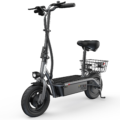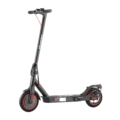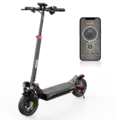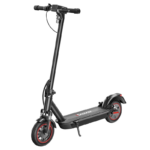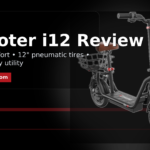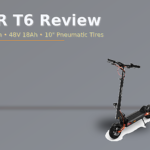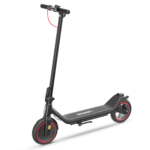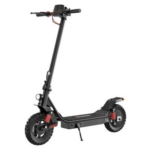- Home
- Scooters
- Electric Scooters
- iScooter i9M
iScooter i9M
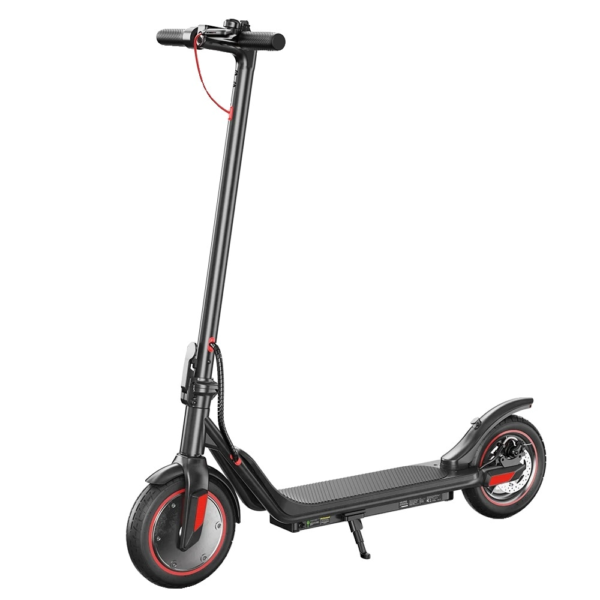

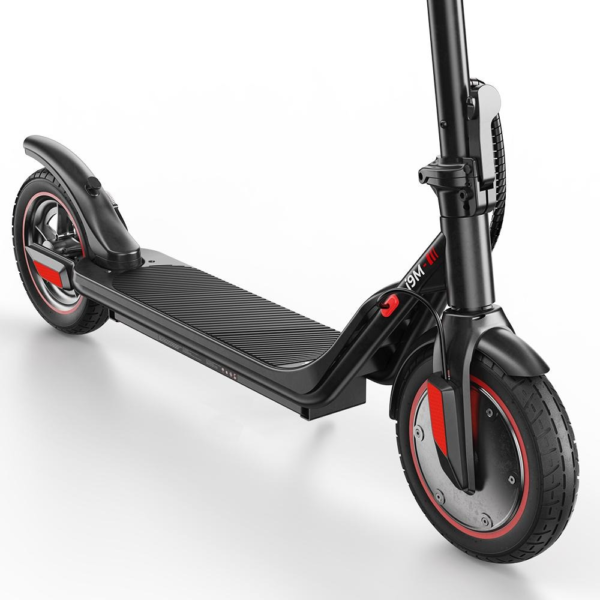

- Battery Range: 18 miles (25 km)
- Top Speed: 22 mph (35 km/h)
- Motor Power: 500 W front hub
- Weight Capacity: 264 lb (120 kg)
- Charging Time: ~5–6 h
- Scooter Weight: 28.9 lb (13.1 kg)
PROS
- More motor power & pace
- 10″ air tires add comfort & grip
- Dual braking system
- 3 ride modes + cruise
- IP54 water resistance
CONS
- Air tires require pressure care
- No suspension
- Range dips at higher speeds
- Stronger motor still FWD-only

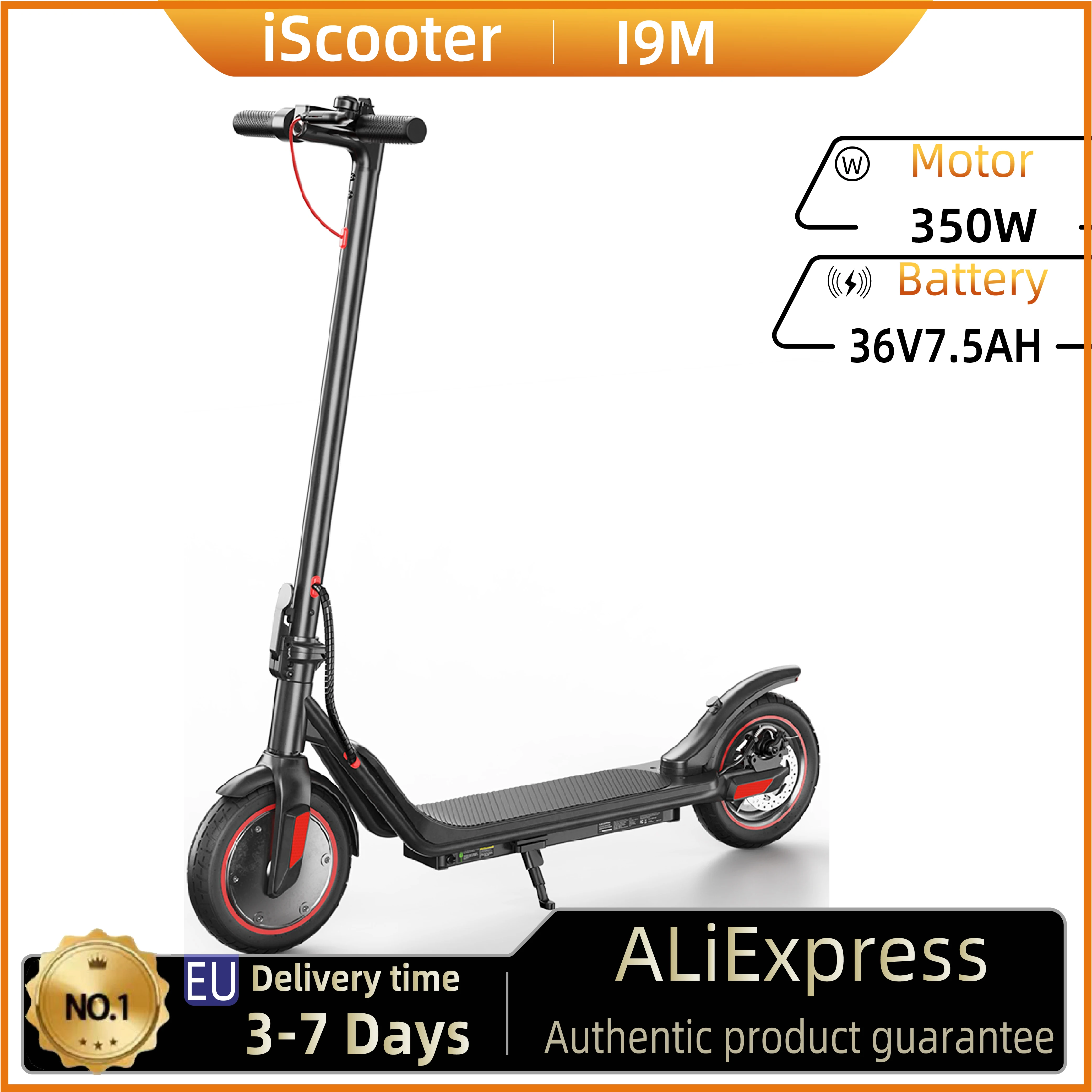
Table of contents
- What Is the iScooter i9M?
- How the iScooter i9M Works
- Key Specifications
- Design & Build Quality
- Performance Fundamentals
- Battery, Range & Efficiency
- Ride Quality & Comfort
- Braking & Safety Features
- Portability & Daily Usability
- Maintenance & Care
- Weather & Seasonal Considerations
- iScooter i9M vs Alternatives
- Who the iScooter i9M Is (and Isn’t) For
- FAQs
- Glossary
A practical city scooter should be simple, sturdy, and efficient. The iScooter i9M aims to be exactly that: a lightweight, foldable commuter with enough punch for everyday errands and last-mile trips. It suits beginners who want an approachable ride, yet it still offers useful touches like app support and cruise control. If you’re cross-shopping, the iScooter i8 is a lighter-duty sibling, while the i9M favors a bit more power and range.
What Is the iScooter i9M?
The iScooter i9M is a compact, foldable electric scooter designed for urban travel. It prioritizes portability, predictable handling, and low-maintenance ownership. You get a 500-watt front hub motor, a modest-capacity battery, and 10-inch pneumatic (air-filled) tires for a comfortable roll over city pavement. Because it weighs about 28.9 lb (13.1 kg), it can be carried up stairs or onto buses without too much strain. Altogether, it’s built for short to medium rides, campus hops, and multi-modal commutes rather than off-road adventures or high-speed thrills.
How the iScooter i9M Works
Electric scooters share a common core: a motor, a controller, a battery, and rider controls. Although the layout is simple, each part matters.
Motor. The iScooter i9M uses a 500 W brushless hub motor placed in the front wheel. In practice, it behaves like a compact, bicycle-style motor scaled down for scooter duty. It produces smooth and quiet torque without gears; therefore, it accelerates cleanly from low speed.
Controller. The controller is the scooter’s “brain.” It takes your throttle input and, moment by moment, decides how much power to feed the motor. It also manages regenerative braking, safety checks, and speed modes. If the battery is the tank, the controller is the fuel injection. As a result, power delivery stays predictable across all three modes.
Battery. A lithium-ion pack supplies energy at up to 42 V when full (36 V nominal). Capacity is about 7.5 Ah, which equals roughly 315 Wh. Put simply, watt-hours are the “size of the tank.” Because higher Wh generally means more range, the pack size frames realistic trip planning.
Throttle. A thumb-press throttle sends acceleration requests to the controller. Since small inputs yield small changes, low-speed control feels natural in crowded lanes or parking lots. Moreover, the thumb motion reduces wrist strain on longer rides.
Brakes. Braking is split between an electronic system on the front (regen/EBAS) and a mechanical rear disc. When you roll off the throttle or squeeze the lever, the electronic system adds motor drag to harvest a bit of energy, while the rear disc provides solid stopping power. Consequently, you get controlled deceleration and a reassuring final bite at the lever.
Key Specifications
| Block | Item | i9M Value |
|---|---|---|
| General | Model | iScooter i9M |
| Class & Use | Compact commuter / urban pavement | |
| App | Tuya (iOS / Android) | |
| Display | Multi-functional LED | |
| Water Resistance | IP54 (splash-resistant) | |
| Max Rider Weight | 264 lb (120 kg) | |
| Performance & Power | Motor | 500 W front-hub, brushless |
| Drive | Front-wheel drive | |
| Speed Modes | 3 | |
| Top Speed (rated) | 22 mph (35 km/h) | |
| Battery, Charging & Electrical | Battery | 42 V max, 36 V nominal, 7.5 Ah (≈315 Wh) |
| Rated Range | 18 miles (25 km) | |
| Charge Time | 5–6 hours | |
| Lighting | Front LED headlight, rear LED tail/brake light | |
| Braking Electronics | EBAS electronic/regen assist (front) | |
| Build & Dimensions | Tires | 10 in (25.4 cm) pneumatic, road pattern |
| Suspension | None | |
| Weight | 28.9 lb (13.1 kg) | |
| Unfolded Size | ~44 × 17 × 45.7 in (112 × 43 × 116 cm) | |
| Folded Size | ~44 × 17 × 18.9 in (112 × 43 × 48 cm) | |
| Handlebars | Fixed height, non-folding | |
| Safety & Control | Mechanical Brakes | Rear disc brake (lever-actuated) |
| Electronic Brakes | Front EBAS/regen (controller-managed) | |
| Throttle | Thumb press | |
| Reflectors | Yes (front/side/rear) | |
| Features & Extras | Cruise Control | Yes (long-press to set at steady speed) |
| Kickstand & Mudguards | Integrated kickstand; built-in mudguards | |
| Warranty & Compliance | Warranty | 12 months (manufacturer) |
| Recommended Age | 12+ | |
| Local Rules | Speed/helmet rules vary by region |
Dimensions are manufacturer-style approximations; the folded height is the smaller figure, while the taller number reflects standing height when unfolded.
Design & Build Quality
The i9M emphasizes simple construction and tidy lines. The frame uses aluminum alloy for a good strength-to-weight balance. Meanwhile, the straight stem keeps the scooter narrow for threading through tight bike-lane gaps. The deck carries a grippy surface with enough usable length to adjust stance front-to-rear. Because the deck height is moderate, stepping on and off feels natural at stoplights.
The cockpit is familiar. You’ll find a central display, a power/mode button cluster, a thumb throttle on the right, and a brake lever on the left. Since the wiring is routed externally near the stem base, service is easier if you ever need to change a throttle, display, or brake lever. Fit-and-finish is consistent for the class. Fasteners seat cleanly, the folding latch engages with a firm click, and the paint resists the scuffs that daily locks and racks can cause.
You won’t find suspension here, and that is intentional. By omitting springs, the scooter saves weight and reduces parts that need service. Instead, it relies on 10-inch pneumatic tires to absorb typical road buzz. Consequently, it rides calmer than many small-wheel, solid-tire scooters while remaining light and straightforward.
Performance Fundamentals
Takeoff and acceleration. Off the line, the i9M starts predictably. Because non-zero start is common, you kick once to 2–3 mph (3–5 km/h), then the motor engages. In Mode 1, response is gentle for crowded paths. In contrast, Mode 2 picks up briskly and suits most commutes. Mode 3 provides the strongest pull yet remains manageable. Since the motor is in the front, the scooter pulls you forward rather than pushing from behind, which often feels stable in straight-line cruising.
Cruising stability. Up to neighborhood speeds, the chassis tracks straight with minimal correction. The 10-inch tires smooth small cracks and tile seams. At the top end, the scooter still feels composed if you keep weight centered and arms relaxed. Therefore, riders who grip the bars lightly and keep knees soft typically experience fewer small wobbles.
Hill behavior. On rolling city blocks and short 7–10% grades, the i9M will climb in its top mode, though speeds will drop with heavier riders. That is normal for compact commuters. When grades stretch for several minutes, move to Mode 2 and let it work steadily. Because the controller limits power to protect the battery, patience pays off on longer climbs.
Battery, Range & Efficiency
Rated vs. real-world. The rated 18 miles (25 km) assumes a light rider, mild temperatures, flat terrain, and moderate speeds. However, real-world range depends on your habits. A 200 lb (91 kg) rider, cool weather, and stop-and-go traffic may cut that figure meaningfully. Conversely, a lighter rider cruising at 12–14 mph (19–23 km/h) on warm, flat paths can approach the rated number.
Why range changes. Temperature affects lithium-ion chemistry. Cold air increases resistance and reduces usable capacity. Hills burn energy quickly, and headwinds matter more than most riders expect because aerodynamic drag rises with speed. Even tire pressure matters; under-inflated tires increase rolling resistance and drain range.
Practical planning. If your round-trip daily ride is 8–10 miles (13–16 km), the i9M fits well with a full charge at home. For longer routes, plan a lunch top-off using the included 42 V charger. In winter, budget extra capacity and slow down a little; both steps preserve range.
Charging habits. For longevity, avoid storing the battery at 0% or 100% for days. After a ride, let the pack cool to room temperature, then charge. For daily use, charging to full is fine. If you store the scooter for weeks, leave it around half. Finally, keep the charge port clean; a soft brush helps, and so does a dust cap.
Ride Quality & Comfort
Tire choice. The i9M’s pneumatic 10-inch tires provide a clear comfort advantage over small, solid tires. They flex over pebbles, soften cobblestone edges, and keep grip in light rain. However, they need air. Check pressure weekly and aim for the manufacturer’s range. Under-inflation makes the scooter feel sluggish and can invite pinch flats. Over-inflation increases harshness and reduces grip, especially on cold mornings.
Ergonomics. Bar width is compact, which suits tight corridors and crowded racks. The thumb throttle reduces wrist fatigue on longer runs. The deck’s usable length allows a staggered stance that spreads weight and improves stability. Stem flex is modest for this category; you’ll still feel a quick give on sharp bumps, yet it returns to center promptly.
Noise and vibration. With no suspension and an aluminum frame, impacts transmit a quick “thunk” if you hit square-edged holes. Even so, the air-filled tires keep harshness modest on normal pavement. If you keep fasteners snug, the scooter remains rattle-free over time.
Braking & Safety Features
Braking system. The i9M blends electronic and mechanical braking. The front motor provides regenerative drag that starts smoothly when you roll off the throttle or touch the lever. Meanwhile, the rear disc supplies the main stopping bite. Together, they shorten stopping distance compared with regen-only systems. Brake feel firms up around mid-lever travel, which helps prevent wheel lock on grippy surfaces.
Lights and visibility. You get a front LED headlight for being seen, plus a rear LED that brightens on brake input. Side reflectors help at dusk and in early morning fog. For true night commuting, consider a helmet-mounted light to project farther down the road. That practice improves reaction time and corner entry vision.
Water resistance. The IP54 rating means splash protection from any direction. It is fine for damp streets and occasional light rain. Nevertheless, avoid deep puddles or jet-washing. Water intrusion is the enemy of bearings and connectors.
Riding norms. Local helmet and speed rules vary. Even so, a properly fitted helmet makes sense on every ride. Gloves improve grip in rain and protect hands if you fall. Bright clothing and reflectors add margin in traffic, especially at dawn and dusk.
Portability & Daily Usability
Folding and carrying. The one-step latch folds the stem down to the rear fender hook. With practice, you can fold it in a few seconds while standing to the side. At 28.9 lb (13.1 kg), short carries up stairs are very doable. For longer walks, pause frequently and switch hands to avoid fatigue. Additionally, keep the stem pointed forward to reduce shin knocks.
Storage. The folded length is about 44 in (112 cm), which fits behind a desk, in a trunk, or under a train seat if you angle it. Keep it upright when possible to limit scratches. Because the deck is relatively low, it slides neatly into narrow gaps next to filing cabinets or lockers.
Security. A compact U-lock around the deck and a fixed rack bar is a good start. Furthermore, take the charger if you park in semi-public spaces. Recorded serial numbers and clear photos help if recovery is ever needed. App-level locks are useful as a deterrent, yet a physical lock still matters.
App basics. The Tuya app typically offers speed-mode toggles, light control, and a lock function that resists rolling by applying electronic drag. Treat app locks as supplemental security, not a replacement for hardware.
Maintenance & Care
Simple, regular checks prevent most problems. As a rule, small habits add up to big reliability.
Pre-ride (30–60 seconds).
- Inspect tires for cuts, and check pressure by feel if you lack a gauge.
- Squeeze the brake lever; verify firm bite without spongy travel.
- Wiggle the stem front-to-back; ensure the latch is fully seated.
- Confirm lights work and reflectors are clean.
Weekly.
- Set tire pressure with a proper gauge. Follow the range printed on the tire sidewall.
- Wipe dust from the deck, lights, and reflectors. Clean scooters are safer and easier to inspect.
- Check the brake caliper alignment. If the rotor rubs, loosen the caliper bolts, center by hand, and re-tighten evenly.
Monthly.
- Inspect all visible fasteners. Use a small torque wrench if you have one.
- Examine brake pads. Replace if the friction material is thin.
- Review the app for firmware updates and error codes; apply updates when recommended.
- Look over cable grommets; replace any that crack or loosen.
Seasonally.
- Deep-clean under the deck and around the motor cable.
- Inspect rear cable runs and fender mounts for wear.
- Refresh handlebar grips if they loosen or tear.
- Rotate tires front to rear if wear is uneven (when tread direction allows).
Because the i9M lacks suspension, there are fewer moving parts to service. Consequently, time spent riding usually outweighs time spent wrenching.
Weather & Seasonal Considerations
Rain. Light rain is acceptable with IP54, but ride slower. Braking distances increase, and painted lines get slippery. Therefore, lower speed by a few mph, cover the brake earlier, and extend your following distance. After a wet ride, dry the scooter with a towel and let it sit indoors so moisture evaporates. Finally, re-lube any exposed metal if rust spots appear.
Cold. In winter, expect reduced range. Batteries prefer room temperature. Store and charge the scooter indoors. Start with a warm pack when possible, then ride. If the deck feels icy to the touch, range will suffer. Thus, plan shorter loops and keep speeds moderate to conserve energy.
Heat. Hot weather reduces motor and controller headroom. Take short breaks after long climbs. Keep the scooter out of direct sun while parked. Elevated temperatures also raise tire pressure, so check it when seasons change. If the ride feels harsh, let a little air out—within the safe range—to regain grip.
Wind. Headwinds drain energy fast. Tuck in elbows and adopt a narrow stance to reduce drag. Tailwinds help; enjoy them and bank the saved battery for later hills.
iScooter i9M vs Alternatives
Versus ultra-budget commuters. The i9M’s 10-inch pneumatic tires, front-and-rear braking blend, and app control set it apart from the most basic models. Those often use solid tires and single braking solutions. Consequently, the i9M rides smoother and stops with more control on mixed pavement.
Versus mid-tier commuters. Heavier scooters in the next tier typically add larger batteries, suspension, or both. They climb longer hills with less slowdown and go farther per charge. However, they are heavier to carry and cost more. If you value light weight and easy handling over raw range, the i9M remains compelling.
Versus performance scooters. High-power rigs deliver blistering acceleration, dual-motor traction, and long-travel suspension. Yet they weigh much more, require more maintenance, and can feel overkill for short urban hops. By contrast, the i9M is calmer and simpler, which many city riders prefer day to day.
Versus off-road scooters. Knobby tires and beefy frames are great for trails, but they add weight and rolling drag. If your route is pavement-only, the i9M’s road tires and modest motor are a better match. As a result, you save weight and preserve battery life.
In short, the i9M excels when portability, predictable manners, and low running costs matter more than top speed or extreme range.
Who the iScooter i9M Is (and Isn’t) For
Ideal for:
- New riders who want a friendly learning curve.
- Students shuttling across campus.
- Multi-modal commuters who combine scooters with trains or buses.
- Urban riders with trips under 10–12 miles (16–19 km) between charges.
- Anyone who values light weight and quick folding over suspension.
Not ideal for:
- Riders tackling long, steep hills every day.
- Heavy cargo haulers.
- Speed enthusiasts who crave hard launches.
- Frequent trail riders who need suspension travel.
Choose this scooter if you prefer a simple tool that does the daily job with minimal fuss. Otherwise, if you regularly exceed its range or climb long grades, consider a larger battery or more powerful motor instead.
FAQs
1) How fast does the iScooter i9M go?
Its rated top speed is about 22 mph (35 km/h). Actual speed varies with rider weight, wind, and grade; therefore, expect slight changes day to day.
2) How far can I travel on one charge?
The rated range is 18 miles (25 km). Real-world numbers depend on speed, temperature, terrain, and tire pressure, so plan conservatively.
3) What tire type does it use?
It runs 10-inch pneumatic tires. They offer better comfort and grip than solid tires, especially on broken pavement and chilly mornings.
4) Does it have regenerative braking?
Yes. The front motor provides electronic braking (regen/EBAS) that assists the rear disc, improving control and energy recovery during longer descents.
5) Is the iScooter i9M water-resistant?
It carries an IP54 rating. That means splash-resistant, not submersible. Consequently, avoid deep puddles and pressure washers.
6) Can I lock it through the app?
The Tuya app typically includes a lock mode that adds electronic drag. Even so, you should still use a physical lock in public areas.
7) Where can I find an “iScooter i9M overview” in simple terms?
Right here. This guide explains how it works, what it does best, and how to care for it in everyday use.
Glossary
Ah (Amp-hours). A measure of how much current a battery can supply over time; higher Ah suggests longer runtime.
Wh (Watt-hours). Battery energy capacity (volts × amp-hours). As a rule, more Wh equals more potential range.
Nominal Voltage. The battery’s typical working voltage, lower than the fully charged voltage; for 10-cell packs, about 36 V.
Controller. The electronic brain that regulates motor power, braking, speed modes, and safety checks.
Regen (Regenerative Braking). A system that slows the wheel with the motor and sends some energy back into the battery.
EBAS. Electronic braking assistance that manages smooth deceleration through the front hub motor.
Disc Brake. A mechanical brake that squeezes pads onto a metal disc at the wheel hub for strong stopping power.
Thumb Throttle. A small lever you press with your thumb to command acceleration precisely.
Speed Modes. Pre-set power limits that control acceleration and top speed for differing conditions.
IP Rating. Ingress Protection; IP54 indicates dust protection and splash resistance.
Pneumatic Tire. An air-filled tire that absorbs bumps and improves grip in varied weather.
Solid Tire. A non-air tire that resists flats but generally rides harsher and grips less on rough surfaces.
Stem Flex. Small elastic movement in the steering column under load; some flex can reduce harshness.
WOT (Wide-Open Throttle). Full throttle position; range drops quickly at WOT as aerodynamic drag rises.
KERS. Kinetic Energy Recovery System; a general term for regen systems that harvest some braking energy.
Specifications
General
| Model The Model specifies the exact version or name of the scooter. It helps identify its unique design, features, and specifications within the manufacturer’s product line. Knowing the model makes it easier to compare options, find compatible accessories, or look up support information. | i9M |
| Brand The Brand identifies the manufacturer or company that designs and produces the scooter. A trusted brand is a sign of quality, reliability, and good customer support. Well-known brands often have higher standards for safety, performance, and after-sales service, giving you more confidence in your purchase. | iScooter |
| Release Date The Release Date indicates when the scooter model was officially launched on the market. This helps you know how current the design, technology, and features are. A newer release date often means updated components, improved performance, and the latest safety or smart features. | 17 November 2025 |
| Recommended Age Recommended Age indicates the minimum age range that the scooter is designed for, based on safety, size, and ease of use. Following the recommended age helps ensure that riders can handle the scooter’s speed, weight, and controls comfortably and safely. Always check local laws and use protective gear, especially for younger riders. | Recommended 12+ |
Performance & Power
| Motor Power (Wattage) What it means: The motor power, measured in watts (W), shows how strong the scooter’s electric motor is. Why it matters: Higher wattage usually means better acceleration, more torque, and improved performance on hills or rough terrain. For example, a 250W motor is good for flat city roads and light riders, while a 500W or 1000W motor provides more power for faster speeds or climbing steep inclines. | 500 W front hub motor |
| Top Speed The Top Speed indicates the maximum speed that the scooter can reach under optimal conditions. It’s usually measured on level ground with a fully charged battery and an average rider weight. A higher top speed allows you to travel longer distances faster, but always ensure you ride within legal speed limits and your personal comfort zone for safety. | 22 mph (35 km/h) |
| Battery Capacity Battery Capacity refers to the total amount of energy the scooter’s battery can store, usually measured in ampere-hours (Ah) or watt-hours (Wh). A higher battery capacity means you can ride longer distances on a single charge, reducing the need for frequent recharging. Keep in mind that actual range can vary depending on rider weight, terrain, speed, and weather conditions. | 42 V 7.5 Ah (315 Wh) |
| Estimated Range per Charge The Estimated Range per Charge indicates the average distance the scooter can travel on a single full battery charge. This range is calculated under optimal conditions, such as flat terrain, moderate speed, and average rider weight. Real-world range may vary depending on riding style, terrain, weather, and load. A longer range means fewer recharges and greater freedom for longer trips. | 18 miles (25 km) |
| Hill Climb Ability Hill Climb Ability describes the maximum incline or slope that the scooter can handle while maintaining stable performance. It’s typically expressed as a percentage or in degrees. A higher hill climb rating means the scooter can tackle steeper hills without losing too much speed or power. Actual climbing performance may vary based on rider weight, battery charge, and terrain conditions. | Up to ~15° climbs |
| Drive System The Drive System refers to how power from the motor is delivered to the wheels. Electric scooters typically use either a hub motor (directly integrated into the wheel) or a chain/belt drive system. A high-quality drive system ensures smooth acceleration, efficient power transfer, and low maintenance. The choice of drive system affects performance, noise level, and overall ride experience. | Front hub motor (FWD) |
Charging & Electrical
| Charging Time Charging Time indicates how long it takes to fully recharge the scooter’s battery from empty to 100% using the standard charger provided. Faster charging means less downtime and more time on the road. Actual charging time may vary slightly depending on battery capacity, charger output, and environmental conditions. | Approx. 5–6 hours |
| Battery Type Battery Type refers to the specific technology used in the scooter’s battery, which affects performance, lifespan, weight, and charging time. Most modern electric scooters use high-quality lithium-ion (Li-ion) batteries because they offer a good balance of energy density, durability, and low maintenance. A reliable battery type ensures consistent power delivery and longer riding ranges. | Lithium-ion pack |
| Removable Battery A Removable Battery means the battery pack can be easily detached from the scooter for convenient charging and replacement. This feature allows you to charge the battery separately, swap it with a spare for extended range, or securely store it indoors in extreme weather. Removable batteries add flexibility and make it easier to keep your scooter powered up wherever you are. | Non-removable internal battery (fixed pack) |
| Regenerative Braking Regenerative Braking is an energy-saving feature that converts some of the energy normally lost during braking back into battery power. When you slow down or brake, the motor works in reverse to generate electricity, which helps extend the scooter’s range and improves overall efficiency. This system also reduces wear on traditional brake components, leading to lower maintenance over time. | Yes (regen via EBAS electronic brake) |
| Lighting Lighting refers to the built-in front and rear lights that enhance visibility and safety when riding in low-light conditions or at night. Good lighting helps you see the road ahead and ensures that other road users can see you. Many scooters include LED headlights, taillights, and sometimes brake lights or side reflectors for added safety and compliance with local traffic regulations. | LED headlight + rear LED/brake + reflectors |
Build & Dimensions
| Scooter Weight Scooter Weight refers to the total weight of the scooter when fully assembled, including the battery. This affects how easy it is to carry, lift, and store the scooter when not in use. A lighter scooter is more portable and convenient for commuting, especially if you need to carry it upstairs or onto public transport. Keep in mind that a sturdy frame and quality components may add to the weight but also contribute to better durability and ride stability. | 28.9 lb (13.1 kg) |
| Maximum Rider Weight Maximum Rider Weight indicates the highest rider weight that the scooter is designed to safely support while maintaining optimal performance and stability. Staying within this limit helps ensure reliable acceleration, braking, and climbing ability, and it protects the frame, suspension, and motor from excessive strain. Exceeding the recommended limit may reduce performance and increase wear on components. | 264 lb (120 kg) |
| Deck Size Deck Size refers to the dimensions of the scooter’s standing platform. A wider and longer deck provides more foot space, allowing you to stand comfortably and adjust your stance while riding. A well-sized deck improves balance and stability, especially on longer rides or at higher speeds. Compact decks, on the other hand, help keep the scooter lightweight and portable. | Low deck; stable, larger tires |
| Handlebar Height Handlebar Height refers to the distance from the deck to the handlebars, which affects your riding posture and comfort. An appropriate handlebar height helps you maintain good balance, reduces strain on your back and arms, and makes steering more comfortable. Some scooters have adjustable handlebars to fit riders of different heights, while others have a fixed height for a streamlined design. | Fixed bar height |
| Folding Mechanism The Folding Mechanism describes how easily and securely the scooter can be folded for carrying and storage. A well-designed folding system lets you quickly collapse the scooter into a compact size, making it convenient to transport on public transit, store under a desk, or fit into a car trunk. Look for sturdy latches and safety locks to ensure the scooter stays firmly in place when folded or unfolded. | Quick folding latch |
| Dimensions Folded Dimensions indicate the size of the scooter when it’s fully folded. This measurement shows how much space the scooter will take up when stored or carried, making it easier to check if it will fit in your car trunk, under a desk, or in a closet. Compact folded dimensions are ideal for commuters who need to bring their scooter on public transport or store it in tight spaces. | Approx. 44 × 17 × 45.7 in (unfolded); folded: quick-fold (not listed) |
| Material Material refers to the primary construction materials used for the scooter’s frame and key components. High-quality materials like aircraft-grade aluminum, reinforced steel, or durable composites provide strength, stability, and a lighter overall weight. A sturdy material ensures the scooter can handle daily wear and tear while maintaining safety and performance. | Aluminum alloy |
Safety & Control
| Brake Type(s) Brake Type(s) describe the braking systems the scooter uses to help you slow down or stop safely. Common brake types include mechanical brakes (like drum or disc brakes), electronic brakes, and foot brakes. Many scooters combine multiple braking systems for added safety and shorter stopping distances. The type and quality of brakes affect your control, especially when riding at higher speeds or on slopes. | Front EBAS electronic + rear disc |
| Suspension Suspension refers to the system that absorbs shocks and vibrations while riding, providing a smoother and more comfortable ride over uneven or rough surfaces. Scooters may have front suspension, rear suspension, or dual suspension for better shock absorption and stability. Good suspension helps reduce rider fatigue and improves control, especially when riding on bumpy roads or off-road paths. | None |
| Tire Type Tire Type refers to the kind of tires the scooter uses, which directly affects ride comfort, traction, and maintenance. Common types include solid (airless) tires, pneumatic (air-filled) tires, or hybrid options. Pneumatic tires offer better shock absorption and a smoother ride on rough surfaces, while solid tires are puncture-proof and require less upkeep. The right tire type helps ensure safe handling and a comfortable ride in different conditions. | Pneumatic street |
| Tire Size Tire Size indicates the diameter and width of the scooter’s tires, which affect ride comfort, stability, and how well the scooter handles different terrains. Larger tires generally offer better shock absorption and a smoother ride over bumps and rough surfaces, while smaller tires keep the scooter lighter and more portable. Choosing the right tire size helps ensure a balance between agility and comfort. | 10-inch |
| Kickstand The Kickstand is a built-in stand that allows you to park your scooter upright when it’s not in use. A sturdy kickstand keeps the scooter stable and prevents it from tipping over, protecting it from scratches and damage. It also makes storing and accessing your scooter more convenient, whether you’re at home, work, or on the go. | Side kickstand |
| Water Resistance Rating Water Resistance Rating indicates how well the scooter is protected against water and moisture, usually shown as an IP (Ingress Protection) rating. This rating helps you understand whether the scooter can handle light rain, splashes, or wet roads without damage. While most scooters are not fully waterproof, a good water resistance rating adds peace of mind when riding in changing weather conditions. Always avoid deep puddles or submerging the scooter to protect its electrical components. | IP54 body |
Features & Extras
| Display/Console The Display (or Console) shows important real-time information about your ride, helping you monitor your scooter’s status at a glance. Typical displays show speed, battery level, distance traveled, and riding mode. Some models also include additional features like Bluetooth connectivity, app integration, or backlighting for better visibility at night. A clear and easy-to-read display enhances safety and convenience on every trip. | LED dashboard |
| Ride Modes Ride Modes refer to the different speed and power settings you can choose to match your riding style or road conditions. Common modes include eco for maximum range and energy efficiency, standard for everyday balance, and sport or turbo for higher speed and stronger acceleration. Switching between ride modes allows you to customize performance, conserve battery, and ride safely in various environments. | 3 modes |
| Smart App Connectivity Smart App Connectivity lets you pair your scooter with a dedicated mobile app via Bluetooth. Using the app, you can monitor real-time ride stats like speed, battery level, and range, adjust settings such as ride modes or cruise control, lock the scooter for added security, and sometimes receive firmware updates. This feature adds convenience and allows you to personalize your riding experience right from your smartphone. | Bluetooth app connectivity |
| Anti-Theft System The Anti-Theft System helps protect your scooter from unauthorized use or theft. This feature can include built-in alarms, electronic motor locks, GPS tracking, or remote locking through a mobile app. A good anti-theft system provides peace of mind when parking your scooter in public spaces, adding an extra layer of security to safeguard your investment. | App lock |
| Cruise Control Cruise Control allows you to maintain a steady speed without continuously holding the throttle. This feature makes longer rides more comfortable by reducing hand fatigue and providing a smoother, more relaxed riding experience — especially on flat, open roads or bike lanes. For safety, cruise control can usually be easily activated or deactivated while riding. | Yes (cruise control) |
| Accessories Included Accessories Included lists the additional items that come with the scooter to enhance your riding experience and convenience. Common accessories may include a charger, kickstand, bell, lights, phone holder, or carrying strap. These extras add value by making your scooter safer, easier to use, and ready to ride straight out of the box. | Bell, reflectors, charger |
Warranty & Compliance
| Warranty Period The Warranty Period indicates how long the manufacturer guarantees the scooter against defects in materials and workmanship under normal use. A good warranty provides peace of mind, showing the brand’s confidence in its product quality. Always check what parts are covered, such as the frame, battery, and motor, and follow the maintenance guidelines to keep your warranty valid. | 12 months (region-dependent) |
| Certifications Certifications confirm that the scooter meets specific safety, quality, and environmental standards set by recognized organizations or regulatory bodies. Common certifications may include CE, RoHS, UL, or other local compliance marks, depending on your region. These certifications ensure that the scooter is manufactured to high standards and is safe and legal to use in your country. | Local micromobility compliance |
Price Comparison




